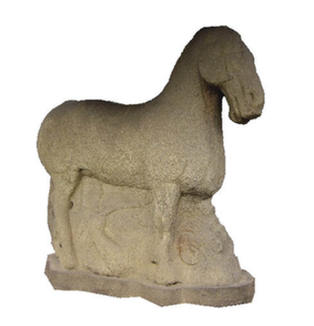|
 |
| The "horse that tramples the Hun" in front of Huo Qubing's tomb. |
Mounted Son of Heaven
In 618, Li Yuan established the Tang Dynasty, assisted by his son Li Shimin, who later succeeded him to become one of the greatest emperors in ancient China.
Li Shimin (598-649) was both a military and administrative talent. He started his military career at the age of 17 and lived the following decade on horseback, fighting heroically for the establishment and consolidation of the Tang Dynasty, thus winning himself the epithet "Mounted Son of Heaven."
In 621, the Tang army fought a decisive battle with Wang Shichong's rebel forces in Luoyang. Li Shimin mounted his battle charger Saluzi (literally Wind-speed Purple) and led a few score of cavalrymen into the enemy ranks, creating chaos in the enemy line. In pushing his way forward, Li lost track of his followers, and when he reached the rear of the enemy ranks, found only general Qiu Xinggong immediately behind him. Suddenly a dike blocked their way, and Saluzi was hit in the chest by an enemy arrow. Quickly turning his horse around, General Qiu Xinggong shot down several enemy troops, then jumped off his horse and gave it to Li Shimin. With one hand leading the wounded Saluzi, and the other wielding a broad sword, Qiu fought by Li Shimin's side, and the two successfully breached the surrounding enemy ranks. All the while, the wounded battle steed stood tenaciously and made its way back to camp with its masters, where it fell dead after Qiu pulled out the arrow from its chest.
According to historical records, Shifachi, a red Persian horse, was Li's battle charger in his campaign against Wang Shichong and Dou Jiande outside Luoyang and at the Wulao Pass. Shifachi continued fighting until he was hit by five arrows. Li Shimin lost three horses in the campaign.
Quanmaogua, a crossbreed with curled hair, was Li's charger in 622 in his expedition in Hebei against a rebel force led by Liu Heita. The horse was hit by nine arrows, six in the chest and three in the back, and died on the battleground. The 622 expedition completed the crusade of the newly established Tang Dynasty against local rebel forces and completed unification of the country.
Six Steeds at the Zhaoling Mausoleum
In 626, at the age of 28, Li Shimin was enthroned as Emperor Taizong. To memorialize his six battle chargers that had died on the battlefield, he ordered the erection of stone carvings at his mausoleum. In 636, he asked famous artist Yan Liben to paint the six horses on paper. Stone artisans followed these paintings in carving the steles. The emperor wrote a short ode for each horse, and had his words carved on the respective steles.
Of the six monumental steles, only the one of Saluzi includes a human figure. It depicts Qiu Xinggong, still clad in his battle apparel, trying to pull an arrow from the horse's chest. This was a special citation for the meritorious general in memory of his military exploits. The wounded steed is depicted as being totally exhausted, its eyes downcast and its thighs slanting backwards.
Each of the six white marble steles is 2.5 meters tall and three meters wide. Three of the steeds are depicted as standing while the rest are galloping. Li Shimin had the stone monuments placed in two temples flanking the memorial altar in the northern part of his mausoleum. He was the only emperor who memorialized his battle steeds in this way.
| 